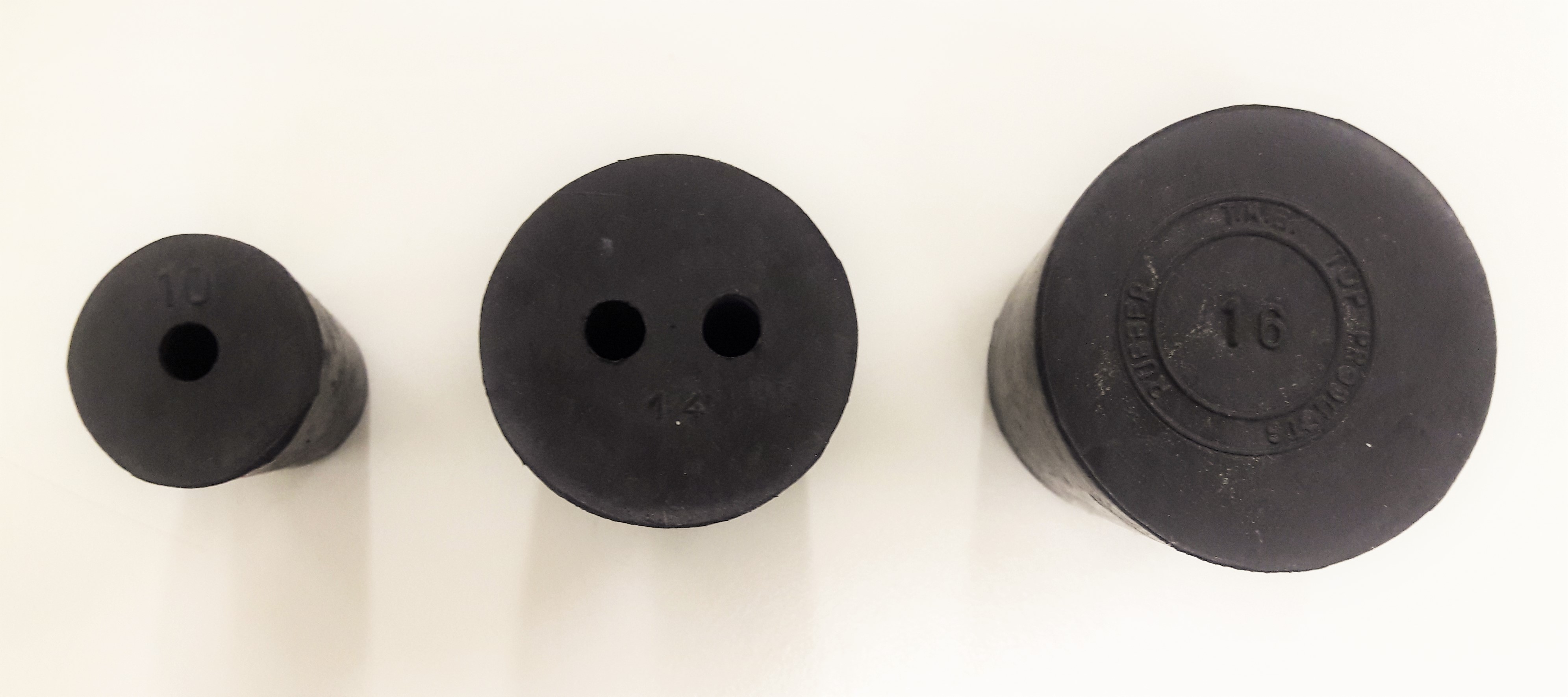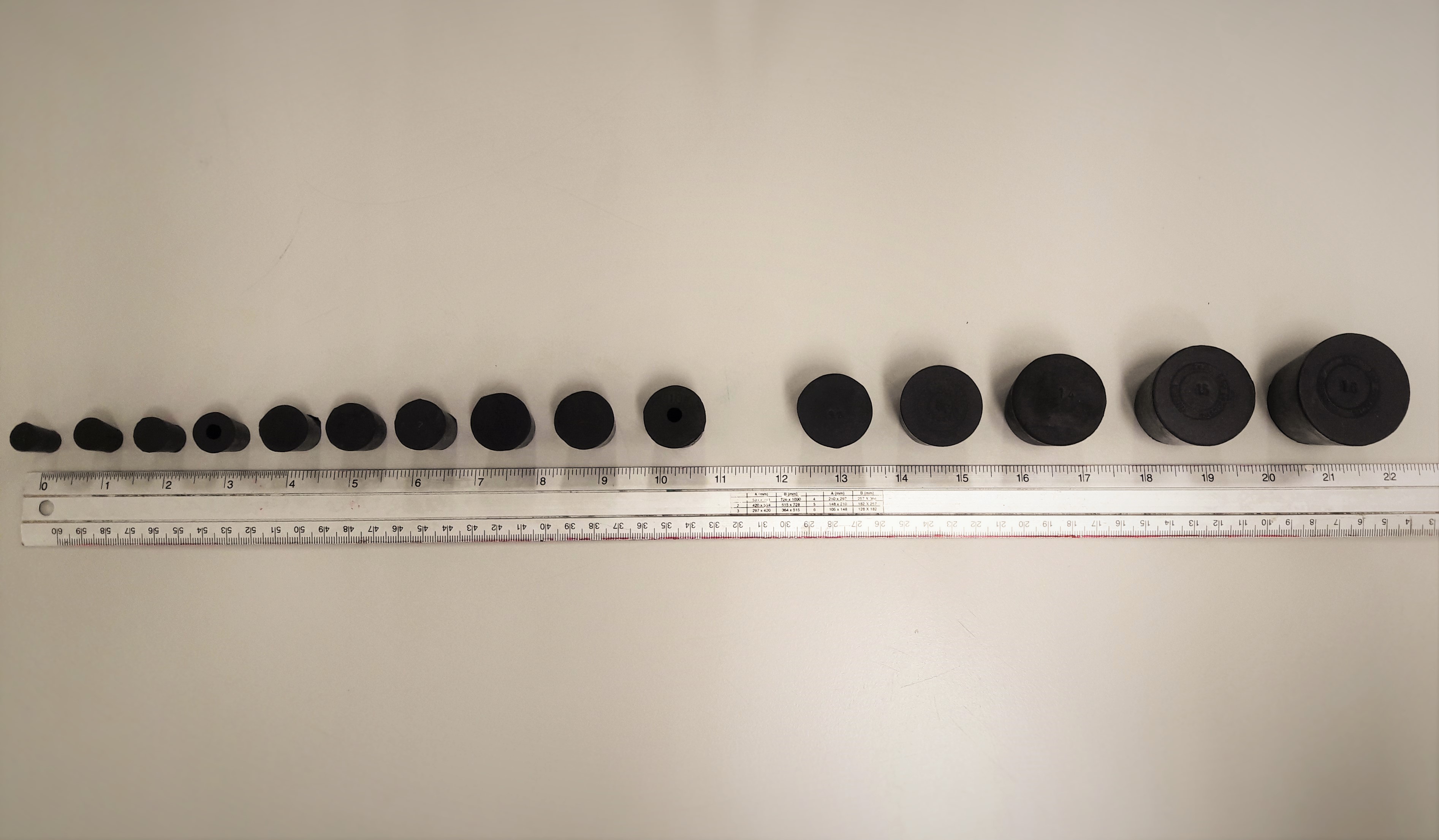Laboratory rubber stopper on:
[Wikipedia]
[Google]
[Amazon]
A laboratory rubber stopper or a 

File:Rubber bung with flask.jpg, Rubber bung size no.5 fits tightly on 50ml Pyrex® Flask
File:Test tube filled with rubber bung.jpg, Other equipments such as glass tubes can be plugged into the holes of the rubber stopper
rubber
Rubber, also called India rubber, latex, Amazonian rubber, ''caucho'', or ''caoutchouc'', as initially produced, consists of polymers of the organic compound isoprene, with minor impurities of other organic compounds. Thailand, Malaysia, and ...
bung
A stopper or cork is a cylindrical or conical closure used to seal a container, such as a bottle, tube or barrel. Unlike a lid or bottle cap, which encloses a container from the outside without displacing the inner volume, a bung is partially ...
or a rubber cork is mainly used in chemical laboratories in combination with flasks and test tube
A test tube, also known as a culture tube or sample tube, is a common piece of laboratory glassware consisting of a finger-like length of glass or clear plastic tubing, open at the top and closed at the bottom.
Test tubes are usually placed in ...
and also for fermentation
Fermentation is a metabolic process that produces chemical changes in organic substrates through the action of enzymes. In biochemistry, it is narrowly defined as the extraction of energy from carbohydrates in the absence of oxygen. In food p ...
in winery
A winery is a building or property that produces wine, or a business involved in the production of wine, such as a wine company. Some wine companies own many wineries. Besides wine making equipment, larger wineries may also feature warehouses, ...
. Generally, in a laboratory
A laboratory (; ; colloquially lab) is a facility that provides controlled conditions in which scientific or technological research, experiments, and measurement may be performed. Laboratory services are provided in a variety of settings: physi ...
, the sizes of rubber stoppers can be varied up to approximately 16 sizes and each of it is specific to certain type of container. As the rubber stopper is used in many experiments, some specific experiment requires a specific material. For example, the M35 Green neoprene
Neoprene (also polychloroprene) is a family of synthetic rubbers that are produced by polymerization of chloroprene.Werner Obrecht, Jean-Pierre Lambert, Michael Happ, Christiane Oppenheimer-Stix, John Dunn and Ralf Krüger "Rubber, 4. Emulsion R ...
stopper is for chemical resistance. For food fermentation
Fermentation is a metabolic process that produces chemical changes in organic substrates through the action of enzymes. In biochemistry, it is narrowly defined as the extraction of energy from carbohydrates in the absence of oxygen. In food p ...
, M18 white natural gum is preferred. For high temperature application, red or white silicone rubber Silicone rubber is an elastomer (rubber-like material) composed of silicone—itself a polymer—containing silicon together with carbon, hydrogen, and oxygen. Silicone rubbers are widely used in industry, and there are multiple formulation ...
stoppers should be used.

Sizes
Rubber bungs can have one or more hole(s) for plugging in tubes depending on the specification of the procedures. To prevent the liquid chemical leaks or escape the container, the rubber bung should fit tightly to the container's opening; the dimension of the rubber bung is of concern. These are some of the sizes that are commonly seen in chemical laboratory.
Additional images
See also
*Bung
A stopper or cork is a cylindrical or conical closure used to seal a container, such as a bottle, tube or barrel. Unlike a lid or bottle cap, which encloses a container from the outside without displacing the inner volume, a bung is partially ...
* Cork borer
A cork borer, often used in a chemistry or biology laboratory, is a metal tool for cutting a hole in a cork or rubber stopper to insert glass tubing. Cork borers usually come in a set of nested sizes along with a solid pin for pushing the remo ...
References